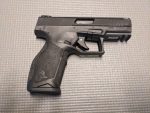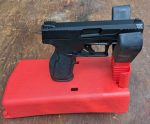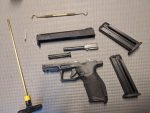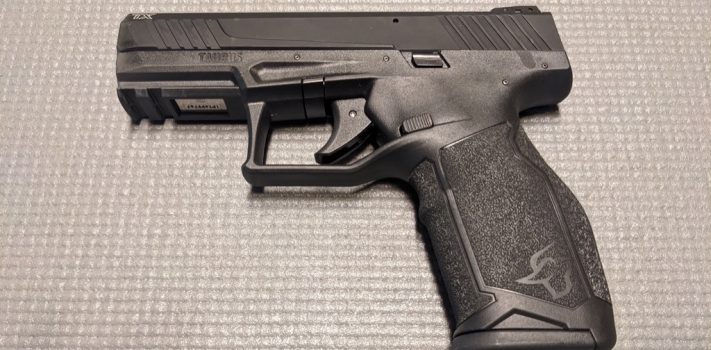It is said that time flies when you are having fun. In that sense, the Taurus TX22 is a time machine. I can pick it up at the range, and suddenly find myself transported two fun-filled hours into the future.
One factor that makes the TX22 fun is its magazine size. Chambered in 22LR, the TX22 holds 16 rounds in its magazine. This sets it apart from most other 22LR handguns, which can only hold 10 rounds in their magazines. This makes a mag dump with a TX22 more fun than a mag dump with a typical handgun chambered in 22LR.
A second factor that makes the TX22 fun is cost. With a length of 7.06 inches, a height of 5.44 inches, and a width of 1.25 inches, the TX22 Model 241 is approximately the same size as a typical self-defense handgun like the Glock 19. But with a cost of less than 10 cents a round for 22LR versus more than 25 cents a round for 9mm, a mag dump with a TX22 is significantly more fun and justifiable than a mag dump with a typical self-defense handgun.
Two other factors that make the TX22 fun are its relatively low levels of recoil and noise. The recoil of 22LR is approximately 1/5 the recoil of 9mm, and the sound intensity is approximately 100,000 times less powerful. This makes a mag dump with a TX22 significantly more fun than a mag dump with a typical self defense handgun.
With a manufacturer-suggested retail price of $349.99 the TX22 represents a lot of fun for the money.
Background
 I heard about the TX22, and it sounded like fun. So I asked Taurus if I could borrow a sample for testing and evaluation. They were kind enough to agree, but wanted to know which particular model I had in mind. The TX22 is currently available in 16 different models. Some come with a red dot sight. Some hold only 10 rounds (less fun). Some are more compact. Some have longer competition barrels. Some have compensators. Some have manual safeties and some do not. Some are black and some are purple and some are olive green and some are flat dark earth in color. I requested model 241 which comes with the standard 4 inch barrel, is black in color, has no manual safety, and comes with two standard-sized (16-round) magazines.
I heard about the TX22, and it sounded like fun. So I asked Taurus if I could borrow a sample for testing and evaluation. They were kind enough to agree, but wanted to know which particular model I had in mind. The TX22 is currently available in 16 different models. Some come with a red dot sight. Some hold only 10 rounds (less fun). Some are more compact. Some have longer competition barrels. Some have compensators. Some have manual safeties and some do not. Some are black and some are purple and some are olive green and some are flat dark earth in color. I requested model 241 which comes with the standard 4 inch barrel, is black in color, has no manual safety, and comes with two standard-sized (16-round) magazines.
Not too long afterward, I stopped by my FFL to pick up a different firearm, and also found the TX22 there waiting for me.
What’s In The Box?
The TX22 arrived in a 9.88 X 6 X 1.75 inch cardboard box. The box contained the following items:
- a warranty card
- a coupon for a Viridian red laser sight
- an NRA membership application card
- a manual
- the handgun in a plastic bag
- two 16-round magazines
- an orange cable tie used as an empty chamber flag
- a magazine loader
- a tag on the trigger guard with safety warnings, recommendations to read the manual, and reference to the limited lifetime warranty
- a suppressor adapter collar
- a cable lock
Reading the Manual
The manual is 48 pages long including the front and back covers. I noted a number of interesting/helpful features:
- It wisely begins with firearms safety (before the reader gets bored), and has the most basic safety reminders printed on the bottom of each page.
- Taurus generally recommends carrying the handgun with an empty chamber.
- Taurus recommends carrying the handgun in a holster.
- The rear sight is adjustable for both elevation and windage.
- The manual is clear and well-illustrated.
- There is no magazine disconnect safety (good news, since this results in a better trigger pull).
- It is necessary to pull the trigger during the disassembly process.
- The magazine release is reversible, for left-handed shooters.
- The manual includes a nice exploded diagram and parts list.
- The limited lifetime warranty extends only to the original owner.
The disassembly instructions included in the manual could be improved. They state that while the handgun is being held in a certain way, the disassembly latch should be pulled down, the trigger should be pulled and released, and the slide should be pushed forward ½ inch. Instead, the trigger should be pulled and released before the disassembly latch is pulled down and the slide is pushed forward. It took a bit of trial and error to figure this out.
Trigger Pull Weight
I tested the trigger pull weight with a Ready Up Gear Trigger Pull Weight Gauge. Five test measurements resulted in a range of from 2.14 pounds to 3.11 pounds, with an average of 2.76 pounds and a mean of 2.84 pounds. There was some slack at the beginning of the pull, but the trigger broke crisply and cleanly after the slack was taken up. All in all it was a rather light trigger by the standards of a self defense handgun, but a fun weight for a fun gun.
Note: Because of their inherently offset firing pin alignment, dry-firing can damage the chamber throat of almost any rimfire firearm. A piece of fired brass will often suffice in place of a snap cap, for dry-firing.
Range Session 1
 It was a beautiful, sunny day in early Autumn with a temperature of 63 degrees Fahrenheit and a light and variable breeze out of the northwest. My hands were a little shaky after a morning of splitting firewood. I set up a target stand in front of the backstop on the improvised range behind my pole barn, and set up a table with a pistol rest 15 yards away.
It was a beautiful, sunny day in early Autumn with a temperature of 63 degrees Fahrenheit and a light and variable breeze out of the northwest. My hands were a little shaky after a morning of splitting firewood. I set up a target stand in front of the backstop on the improvised range behind my pole barn, and set up a table with a pistol rest 15 yards away.
I began by loading a single round of Federal 38 grain copper-plated hollow point in the magazine and chambered it. I then aimed at the center target and pulled the trigger. The bullet struck about 4 inches to the left and 1 inch below the point of aim.
I tried adjusting the sights and using single rounds to move the point of aim closer to the center of the target, but received inconsistent results. I finally loaded and fired 10 rounds to get a sense of how they would group. This initial group was about 6 inches in size fired from rest from 15 yards. I decided to try a different load.
Next I loaded 10 rounds of Browning 40 grain LRN. This load also produced a group about 6 inches in size.
Then I tried 10 rounds of Federal Auto Match 40 grain LRN. This produced a nicer group that all fell within 2 inches of the point of aim.
MaxxTech 40 grain LRN was the next load that I tried. It produced an okay group with 1 flyer.
I then tried the Auto Match, Browning, and Federal 38 grain loads again. My results with all loads were improving. I don’t know if the bore was smoothing out, if my hands were settling down, or there was some other reason for the improvement.
An aside: During the course of all of this, I was amazed when a squirrel and then later a chipmunk each stopped by for a few minutes to watch me shoot. I don’t know if this was an expression of curiosity, of contempt for my accuracy, or of some other emotion on their part. I do know that it was a pretty clear sign of very low hunting pressure on small mammals on my property.
Next I set up a Sput target in front of the backstop, loaded 16 rounds, and fired offhand. I did this with several different loads. In this process, I found the Sput target to be an effective but not spectacular reactive target when used with .22LR. I also found the mag loader supplied with the TX22 to be highly effective.
I repeated the process with a steel target. The Sput target gave more specific feedback than the steel target. The Sput target produced a cloud of red powder if the target was hit near the center, and a cloud of blue powder if the target was hit farther out. The steel target just jumped no matter where it was hit. Although the Sput target provided more information, the steel target was more fun.
 Throughout the range session, I had only one round that failed to fire. When I removed the round from the chamber, the indentation from the primer strike seemed appropriately deep. When I re-chambered the round and tried again, it fired successfully. I believe the failure to fire was due to primer compound being incompletely spread inside the rim of the casing. Thus, the failure to fire was due to a problem with the ammo rather than due to a problem with the handgun.
Throughout the range session, I had only one round that failed to fire. When I removed the round from the chamber, the indentation from the primer strike seemed appropriately deep. When I re-chambered the round and tried again, it fired successfully. I believe the failure to fire was due to primer compound being incompletely spread inside the rim of the casing. Thus, the failure to fire was due to a problem with the ammo rather than due to a problem with the handgun.
I was impressed that the TX22 was able to feed, fire, and eject such a wide variety of loads. This was particularly true since the MaxxTech rounds tend to be quite lightly loaded and thus difficult for some semiautos to eject.
I enjoyed the range session immensely, and believe that this is the greatest strength of the TX22. It would make an excellent firearm for introducing a first-time shooter to handgun use.
Cleaning
 The cleaning process was very straightforward. I disassembled the handgun using the improved disassembly process that I outlined in my discussion of the manual above. I found the thread protector at the end of the barrel to be somewhat loose, and was uncertain what influence this may have had on accuracy. I used solvent patches through the bore until clean followed by a dry patch, the same process for all accessible metal surfaces, and then a thin film of CLP in the bore and on the accessible metal surfaces.
The cleaning process was very straightforward. I disassembled the handgun using the improved disassembly process that I outlined in my discussion of the manual above. I found the thread protector at the end of the barrel to be somewhat loose, and was uncertain what influence this may have had on accuracy. I used solvent patches through the bore until clean followed by a dry patch, the same process for all accessible metal surfaces, and then a thin film of CLP in the bore and on the accessible metal surfaces.
Range Session 2
I had a number of friends over for a range session, and invited them to try the TX22:
“Dutch Mom” found the TX22 to be light, easy to shoot, and very nice for smaller hands. Her overall impression was that it was very comfortable to shoot.
“Hummingbird” also felt that it was easy for smaller hands to grip. She found it to be very smooth shooting. Her major impression was that it is a very nice gun.
“Jungleboy” (who earned this title by growing up in the jungle as a missionary kid) found the TX22 to be comfortable to grip and smooth shooting.
“Betsy Ross” commented that the TX22 is lightweight, feels nice, is accurate, and very easy to shoot. Betsy did experience one failure to feed.
“Obi Wan Kenobi” found the TX22 to be lightweight as well as easy and fun to shoot. But Obi didn’t feel that the sights lined up well.
“Cool Hand Luke” felt that the TX22 made for confident shooting.
Et Cetera
I enjoyed shooting the TX22 so much that I kept it a little longer than I typically would, in my testing. I used it to test Yankee Thunder Purple Pigeon Hooks. I used it in a range session with my friend, “Hawkeye.” I just kept finding excuses to hang on to it a little bit longer.
 I tried to think of some excuse to buy the TX22, but I already owned enough handguns chambered in 22LR. I just could not justify buying yet another handgun, no matter how hard I tried. But I will say this: If you don’t already have a handgun chambered in 22LR, then I recommend that you buy a TX22. And if you could use another handgun chambered in 22LR, then I recommend that you buy a TX22. If you need a handgun for use in training new shooters, I recommend the TX22.
I tried to think of some excuse to buy the TX22, but I already owned enough handguns chambered in 22LR. I just could not justify buying yet another handgun, no matter how hard I tried. But I will say this: If you don’t already have a handgun chambered in 22LR, then I recommend that you buy a TX22. And if you could use another handgun chambered in 22LR, then I recommend that you buy a TX22. If you need a handgun for use in training new shooters, I recommend the TX22.
Disclaimer
Taurus was kind enough to loan me a sample of their TX22 Model 241 for testing and evaluation. Ready Up Gear had previously provided me with a sample of their Trigger Pull Weight Gauge for an earlier review. Sput Targets had previously provided me with a sample of their targets for an earlier review. Yankee Thunder had previously provided me with a sample of their Purple Pigeon Hooks for an earlier review. I tried not to let the kindness of any of these vendors interfere with the objectivity of this review, and I believe that I have succeeded. I did not receive any other financial or other inducement to mention any vendor, product, or service in this article.










